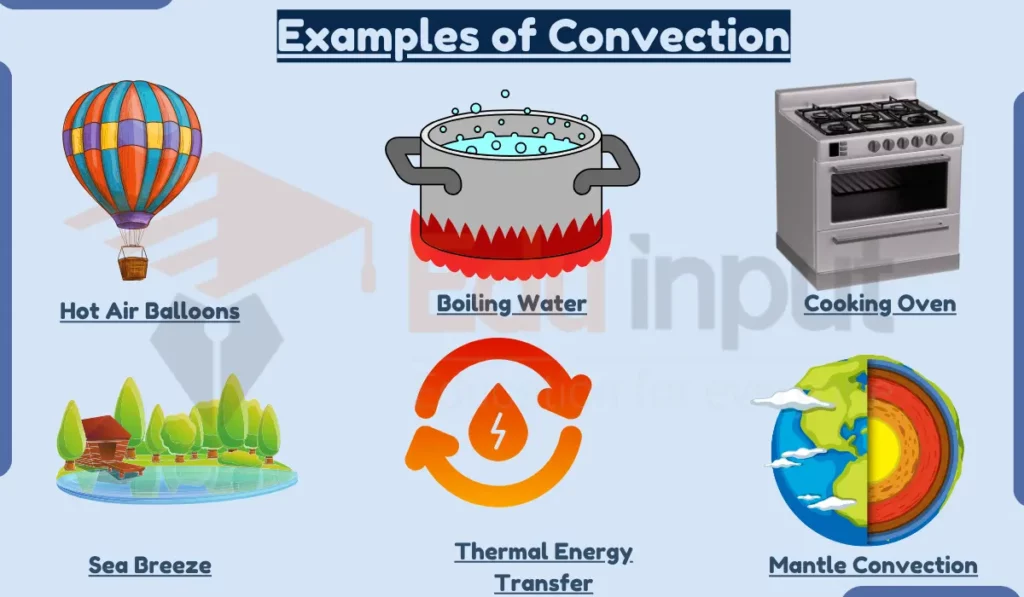Convection Examples
Convection occurs when heat is transferred through the movement of fluids, such as in boiling water, air currents, wind turbines, refrigerators, and air conditioners.

Examples of Convection
Here are the 10 examples of convection:
1. Hot Air Balloons
Hot air balloons rise due to convection currents of hot air. The burner heats the air inside the balloon envelope, lowering its density. The hot, less dense air inside the balloon is more buoyant and rises upward through the cooler, denser outside air. This creates a convection current. As the air in the balloon cools, the pilot must reheat it to maintain flight.
2. Boiling Water
When water boils, convection currents bring hot water from the bottom of the pot up to the surface as it heats up. The hot water has lower density than the cooler water, so it rises while the cooler, denser water sinks. This circulation distributes the heat from the stove evenly through the pot through continuous convection loops. Without convection, the water at the bottom would overheat.
3. Cooking Oven
Convection ovens use fans to circulate hot air around food for even heating. The oven element heats the air, lowering its density. The fan moves the hot air in currents around the oven, transferring heat from the elements to the food through airflow. As air cools at the food’s surface, it sinks back down to be reheated. The convection currents improve cooking efficiency.
4. Sea Breeze
During the day, land heats up more quickly than the ocean due to differences in their heat capacities. The hot air over the land becomes less dense than the cooler ocean air, causing it to rise while the higher density cooler air from the ocean surface moves inland to replace it. This sets up a convection current, experienced at the coast as a cool sea breeze.
5. Thermal Energy Transfer
Convection transfers thermal energy as hotter molecules naturally rise and disperse while colder molecules sink. This motion sets up convection cells and circular current flows as fluids are heated. Hotter liquids and gases expand, becoming less dense, while colder regions sink. This leads to continuous convection loops transporting thermal energy.
6. Mantle Convection
Slow convection currents in the mantle deep below Earth’s crust drive tectonic plate motions on the surface. Mantle material heated by the core rises while cooler material sinks down, establishing circulation. Hot upwellings push plates apart at mid-ocean ridges while downwellings pull plates under continental plates in subduction zones.
7. Weather Systems
On a global scale, convection patterns in the atmosphere and oceans create weather systems as air and water masses circulate across different regions. The circulation is driven by temperature and density differences. Solar heating combined with convection impacts weather phenomena including storms, precipitation, and winds.
8. Pipe Heating Systems
Hot water or steam heating pipes found in homes rely on convection to spread warmth. As the hot water rises due to its lower density, cooler water falls to replace it, establishing natural circulation. The convection current brings hot water throughout the pipe system, transferring thermal energy for heating rooms.
9. Cooking with Convection Ovens
Convection ovens use an internal fan to accelerate cooking through improved hot air circulation. The fan distributes hot air so it contacts food more efficiently, overcoming limitations of radiant heating alone. Airflow transfers heat by convection, as hot currents rise from elements and cooler air sinks to be reheated.
10. Cloud Formation
Clouds form when warm air containing moisture rises from the Earth’s surface, expands and cools in the atmosphere. The convection current brings surface air upward. As it expands, the air cools causing the moisture to condense into tiny droplets that create visible clouds. This demonstrates convection driven by changes in density.

 written by
written by 





Leave a Reply